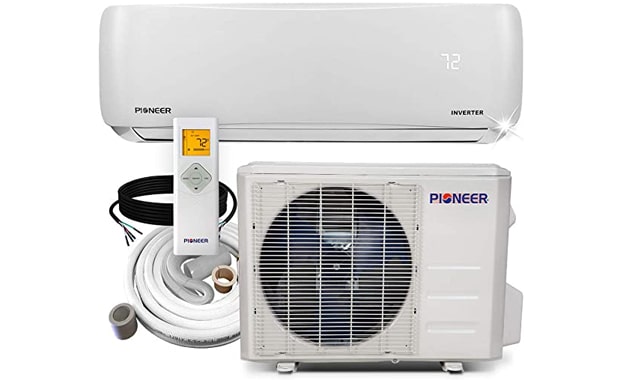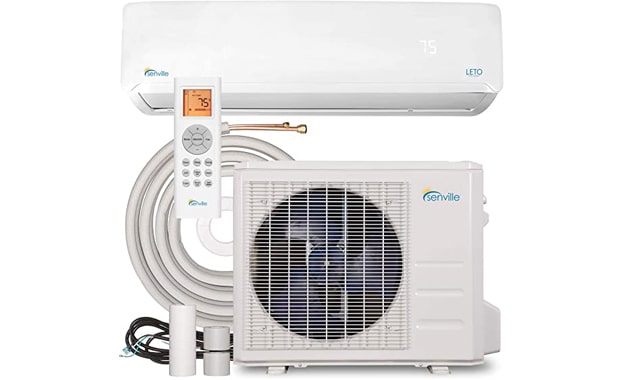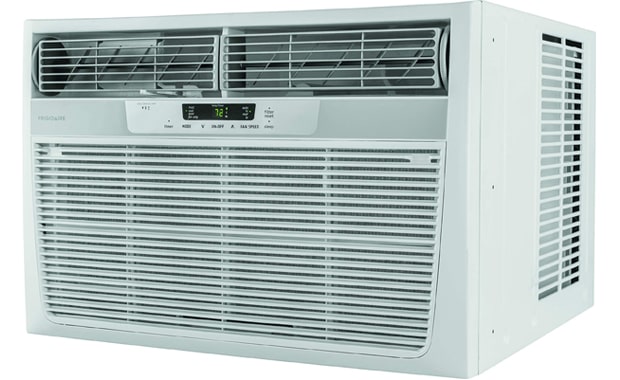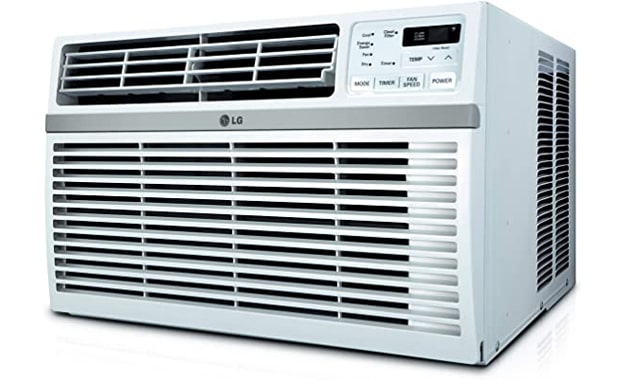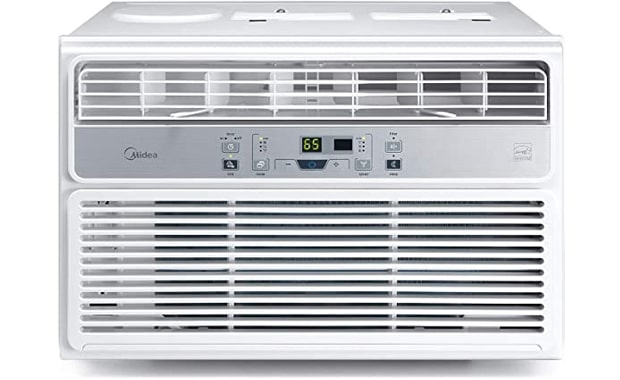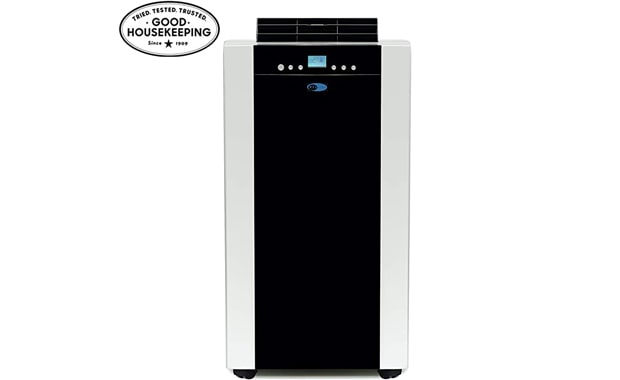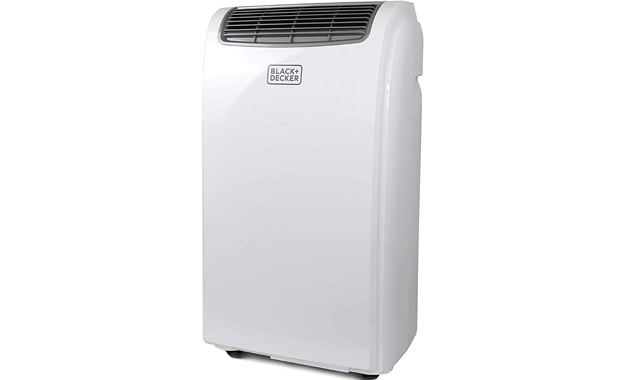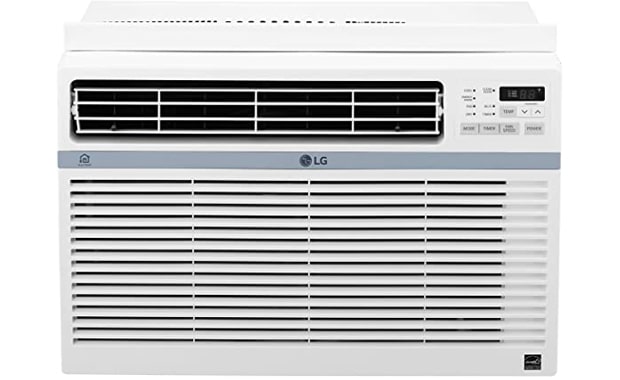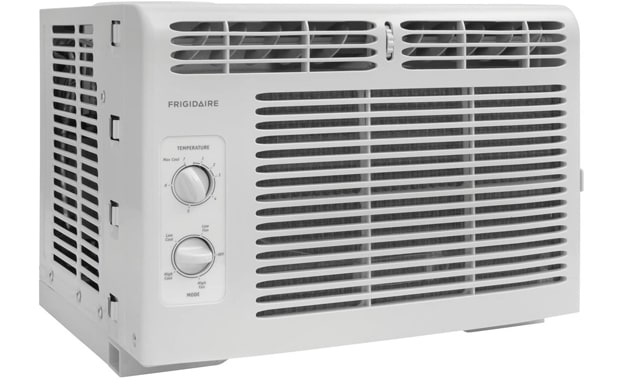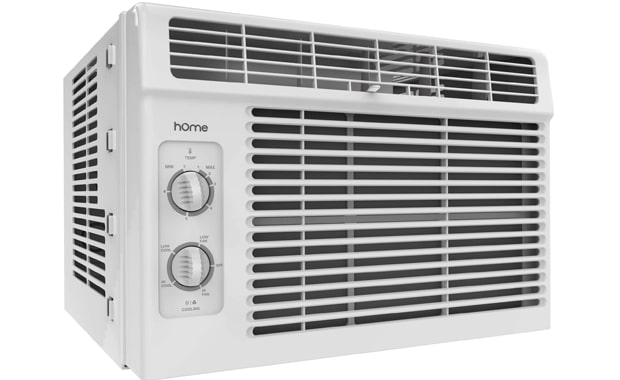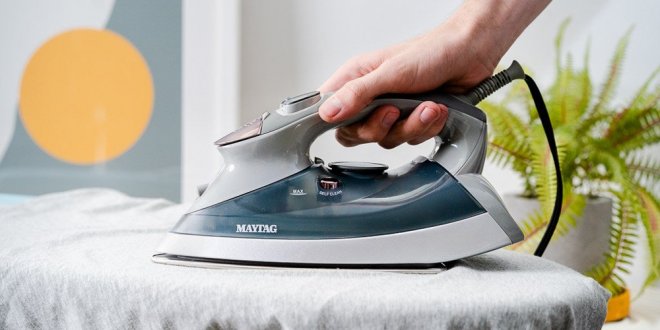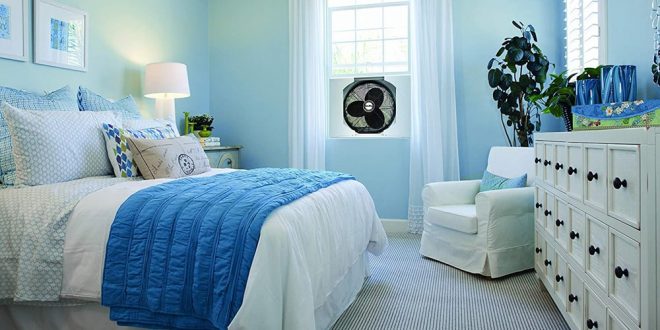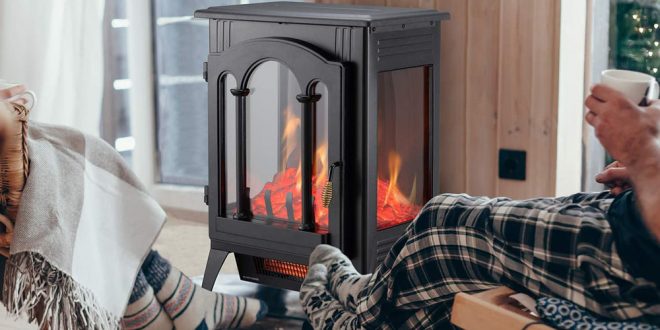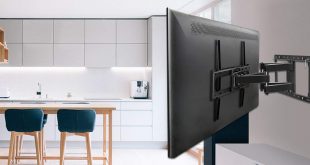If you live in a place where the weather can get unbearably warm, chances are you have decided that you need an air conditioner to keep your home cool and comfortable. The question is how to choose the best air conditioner to meet your particular needs. There are a number of factors to consider when selecting an air conditioner. First of all, you need to decide what type of unit is best suited to your home and needs, perhaps a window unit, a portable model, ductless, or some other option. An important consideration is cooling capacity, keeping in mind your room size, but your budget is also an important factor. Depending on the cooling solution you choose, you may spend anywhere from $100 to several thousand dollars on a system. For all the need-to-know details about what to look for when you buy an air conditioner, read on.
Related:The 10 Best Air Purifiers
Best Overall: Pioneer WYS012-17 Air Conditioner Inverter+
This mini-split/ductless model from Pioneer offers cooling and heating solutions in a single system at a remarkably affordable price. It offers four operating modes: cooling, heating, dehumidification, and ventilation. With a SEER of 19.5 in its cooling mode, it is the most energy-efficient of the models reviewed. This unit comes with an abundance of features for greater convenience and comfort. A wireless remote digital controller provides the user with the ability to easily adjust settings and fine-tune their comfort. In addition to a cloud programmable wireless internet remote function, other features include a timer function, a night mode function, an auto switchover mode, and an auto restart function that automatically returns the system to its program after a power outage. The particular model reviewed here is just one in a series, each one offering different capacities up to 36,000 BTU, so you can choose the model/size that meets the needs of your particular space. When purchasing this system, keep in mind that it consists of two units, an indoor unit and an outdoor unit and that depending on your skills and resources you may want some professional assistance with installation, something that needs to be factored into the calculation of your initial cost. However, given that you can expect this system to give you years of comfortable, convenient, and efficient service, your investment is sure to pay for itself.
- Ductless cooling and heating in one unit
- Affordable
- High efficiency
- Uses standard household power
- Type: Wall mount mini-split ductless
- Cooling capacity: 9000 BTU
- Recommended square feet: 300-400 sq. ft.
- Installation: Single point power entry may require professional assistance
- Dimensions: Indoor 31.5×7.5×11.5” / outdoor 31.5x12x22”
- Weight: 125 lbs
- Voltage: 110~120 v
- Noise: “Quiet operation”
- Energy efficiency (SEER): 19.5
- Reliability / durability: Galvanized metal construction
- Other features: controls, settings/ filter cleaning: Dimmable LED display, multifunction wireless remote controller, washable air filters, multispeed fan motor
- Combined heating and cooling system at an affordable price
- Very high efficiency
- 4 operating modes: cooling, heating, dehumidification, ventilation
- Programmable
- Installation may require some professional assistance.
Related:The 12 Best Air Compressors
Best Split-System: Senville SENL-18CD Mini Split Air Conditioner
This Senville ductless/mini-split system is a two-in-one heating and cooling solution, boasting dehumidification, fan, and turbo functions. Its low price of $899.99 makes it excellent value, even taking into account the cost of professional installation, which is required according to the manufacturer. The installation kit and all needed materials and parts are included in the base price, and the installation cost will be more than made up by the efficient operation of this system, which boasts a SEER of 19. This mini-split also features a 5-year warranty, in contrast with the 1-year warranty more typically offered. This system also boasts many other features to enhance your comfort and convenience, including electronic controls, 8-way air direction, a 24-hour on/off timer, and a washable filter, Since this system is part of a model series featuring cooling capacity options up to 24,000 BTU, you can choose the size best suited to your climate control needs.
- Ductless cooling, heating, and dehumidifier in one unit
- Very quiet operation
- Energy efficient
- Fan and turbo function
- Type: Mini-split air conditioner/heat pump
- Cooling capacity: 9000-18000 BTU
- Recommended square feet: 100-1250 sq. ft.
- Installation: Professional installation required
- Dimensions: 32.87×7.8×11.02” indoor/30.31×11.81×21.81” outdoor (9000 BTU)
- Weight: 82.7 lbs.
- Voltage: 110v/220v
- Noise: Quiet operation (30dB)
- Energy efficiency (SEER): 19
- Reliability / durability: 5-year manufacturer warranty
- Other features e.g. controls, settings/ filter cleaning: Built-in heat pump, washable filters
- Heating and cooling in one unit.
- Affordable and efficient
- 5-year warranty
- Requires professional installation
Frigidaire FFRH1822R2 18500 BTU 230V Median Slide-Out Chassis Air Conditioner
The slide-out chassis of this Frigidaire model it suitable for window or wall installation. Not only will it meet cooling needs for spaces up to 1050 square feet, it also offers supplemental heating capacity, making this system excellent value at $749.00. Among its many features are customizable electronic controls, tilt-access washable filter, and a full-function remote control. Its customizable functions include thermostatic temperature control, 24-hour on/off timer, automatically adjusting fan settings, energy-saving, and more. This unit requires a special 230V electrical outlet and will not operate with a standard 115V household electrical outlet.
- Cooling and heating in one unit
- Window or wall installation
- The filter is washable, antibacterial mesh with tilt-out access
- Full-function remote control, multi-speed controls
- Type: Window/wall
- Cooling capacity: 18,500 BTU
- Recommended square feet: 1050 sq. ft.
- Installation: Slide-out chassis for window or wall
- Dimensions: 25.38×23.63×17.88”
- Weight: 118 lbs.
- Voltage: 230v
- Noise: Quiet
- Energy efficiency (SEER): Not Energy Star Qualified
- Reliability / durability: Full 1 year parts and labor warranty plus additional 4 years limited warranty on sealed system.
- Other features: controls, settings/ filter cleaning: Electronic controls, 8-way air direction, multiple speeds, washable filter, 24-hour on/of timer
- Slide-out chassis for window or wall installation
- The full-function remote control, control the temperature and fan speed remotely
- Supplemental heating capability
- Special 230V electrical outlet required (Unit will not work with standard 115V outlet).
Best for Large Spaces: LG LW1216ER 12,000 BTU 115-Volt Window Air Conditioner
The LG 12, 000 BTU 115V window-mounted air conditioner provides an excellent cooling solution for spaces up to 550 square feet. Easy to install and energy-efficient with an EER of 12.1, this unit can save you even more with its energy Saver function, Despite its economical price of around $500, this LG is loaded with other features including 24-hour on/off timer, a slide-out washable filter, 4-way air direction, a dehumidification function up to 3.8 pints per hour, and a full-function remote. This unit offers all this functionality with a 1-year warranty.
- Easy to install
- Energy efficient
- Dehumidifier
- Multiple control/setting features
- Type: Window
- Cooling capacity: 12,000 BTU
- Recommended square feet: 550 sq. ft.
- Installation: The kit included, max window width 39”
- Dimensions: 25.62×22.20×15”
- Weight: 81 lbs.
- Voltage: 115v
- Noise: “Quiet”
- Energy efficiency (SEER): 12.1 EER
- Reliability / durability: 1-year warranty
- Other features: controls, settings, filter cleaning: Energy saver, 24-hour on/off timer, slide-out washable filter, 4-way air direction, dehumidification, full-function remote
- Window mounted
- Dehumidification
- Affordable
- N/A
MIDEA MAW12R1BWT Window Air Conditioner
This MIDEA 12000 window-mounted air conditioner is a breeze to install: with the included mounting kit, nothing more than a screwdriver is required, and it fits window frames 23-36” x 15.5” without modification. Despite its low price tag of just $379.99, this unit comes with features including a front panel LED display, LCD remote control, and a fresh air vent control function. Energy Star Certified, this MIDEA unit boasts a timer mode, an energy saver mode, and a sleep mode. All this functionality comes with a 1-year warranty.
- -in-1 functionality combines air conditioning, dehumidification, and fan-only modes
- Fast cooling, efficient for rooms up to 550 square feet
- LED digital display panel
- Easy installation
- Fresh air vent control
- Type: Window
- Cooling capacity: 12,000 BTU
- Recommended square feet: Up to 550 sq. ft.
- Installation: Mounting kit included, no special tools required, fit window frame 23-36”x15.5” without modification
- Dimensions: 21.89×18.98×14.65”
- Weight: 74.8 lbs.
- Voltage: 1000 watts
- Noise: 57.5/59.3/60.5 dB
- Energy efficiency (SEER): Energy Star certified, EcoSave functionality
- Other features: controls, settings/ filter cleaning: Remote control, LED digital display, fresh air control, timer
- Fast, efficient cooling
- Easy to install
- Some consumers report instructions that come with the unit are insufficiently detailed
Whynter ARC-14S 14,000 BTU Dual Hose Portable Air Conditioner
If a mobile cooling solution is better suited to your needs than a more fixed installation, the Whynter ARC-14S portable air conditioner is mobile without compromising power. Thanks to its dual hose operation, this portable air conditioner can quickly cool up to 500 square feet while dehumidifying up to 101 pints per day. This unit offers three operational modes, fan, and dehumidifier, in addition to air conditioning. Among its features are a 24-hour programmable timer, full thermostatic control, auto-restart after power outages, and an auto-drain function that fully expels all condensation automatically. Easy to install, this portable air conditioner is an effective, flexible cooling solution.
- fan speeds, 3 operational modes: air conditioner, fan, or dehumidifier
- Can cool up to a 500 square feet space
- Full thermostatic controls
- Type: Portable
- Cooling capacity: 14,000 BTU
- Recommended square feet: Up to 500 sq. ft.
- Installation: Window, “easy installation”
- Dimensions: 19x16x35.5”
- Weight: 80 lbs.
- Voltage: 115v
- Noise: <56 dBA
- Reliability / durability: 1-year warranty
- Other features: controls, settings/ filter cleaning: 3 fan speeds, 3 modes: air conditioner, fan, dehumidifier, full thermostatic control with digital readout, 24-hour programmable timer, washable pre-filter, dual hose
- Mobile
- Powerful
- Cooling capacity is insufficient in some climates
- Some consumers find the unit too noisy
BLACK+DECKER BPACT08WT Portable Air Conditioner
This floor-standing portable unit is an effective cooling solution for rooms up to 200 square feet. Thanks to rolling casters, it can be easily moved to wherever it is needed. At the very affordable price of $329.99, this unit features an intuitive remote control, top-mounted LED display and a 24-hour timer. Its filter is removable for easy cleaning. In addition to cooling and fan modes, this model also offers bucket-less, self-evaporating dehumidification. For small spaces, this Black+Decker model provides an easy, effective, and flexible cooling solution.
- Cooling, fan, and dehumidifying modes
- Quiet and powerful
- Perfect for small rooms
- Simple and quick to install
- Easy to use and clean
- Type: Portable
- Cooling capacity: 8000 BTU
- Recommended square feet: Up to 200 sq. ft.
- Installation: Easy installation, requires double-hung or sliding window
- Dimensions: 16.5×11.5×26”
- Weight: 52.9 lbs.
- Voltage: 115v
- Noise: 75 dB
- Energy efficiency (SEER): 8.42 EER
- Reliability / durability: 1-year warranty
- Other features: controls, settings/ filter cleaning: Top-mounted LED display, 24-hour timer, filter removable for cleaning, 3 functions: cool, fan, dehumidify
- Very affordable
- Easy to install and use
- Suitable only for small spaces
- Requires scarce floor space in a small room
- Relatively noisy compared to some other options
LG LW8017ERSM Smart Window Air Conditioner (Wi-Fi), 8,000 BTU 115V, White
This LG wall-mounted air conditioner is an unbeatable value. Easy to install with the included installation kit, it has a cooling capacity of up to 340 square feet and boasts an energy efficiency rating of 12.1, Operating at a relatively quiet 58/52 dB (high/low) noise level, it can save you even more money with its energy saver function. With its full-function remote control, you have access to its on/off timer, 3 fan speeds, and 3 cooling speeds.
- Window-mounted
- Cools a room up to 340 square feet
- cooling speeds/3 fan speeds
- Type: Window
- Cooling capacity: 8000 BTU
- Recommended square feet: Up to 340 sq. in.
- Installation: Installation kit included, max window width 36”
- Dimensions: 19.4 x 19.6 x 12.4 inches
- Weight: 58 lbs.
- Voltage: 115v
- Noise: 58/52 dB (high/low)
- Energy efficiency (SEER): 12.1 EER
- Reliability / durability: 1-year warranty
- Other features: controls, settings/ filter cleaning: 3 fan speeds/3 cooling speeds, energy saver option, 24-hour on/off timer
- Quiet
- Easy to use
- Chassis not as heavy-duty as some other models
- Fan not as powerful as some others
Frigidaire FFRA0511R1E 5, 000 BTU 115V Window Air Conditioner
Frigidaire’s FFRA0511R1 5, 000 BTU 115V window-mounted mini-compact air conditioner is a cooling solution for a room up to 150 square feet and very affordable at only $255,49. This unit is quick and easy to install with the included window mounting kit. Its mechanical rotary controls allow the user to access two cool speeds, two fan speeds, and 2-way air direction. The slide-out air filter is easy to clean. This unit comes with a 2-year warranty.
- Window-mounted
- Uses standard 115V electrical outlet
- Cools up to 150 square feet
- Mechanical rotary controls: 2 cool speeds, 2 fan speeds, 2-way air direction
- Energy efficiency ratio (EER) 11.1
- Type: Window
- Cooling capacity: 5000 BTU
- Recommended square feet: Up to 150 sq. ft.
- Installation: Window width 26-36”
- Dimensions: 12x16x15.25”
- Weight: 41 lbs.
- Voltage: 115v
- Noise: “Quiet”
- Energy efficiency (SEER): 11.1 EER
- Reliability / durability: 2-year warranty
- Other features: controls, settings/ filter cleaning: 2 cool speeds, 2 fan speeds, 2-way air direction, washable filter
- Window mounted, compact
- 2 cool speeds, 2 fan speeds
- Easy to install
- Suitable only for small rooms
- No remote control
hOmeLabs 5000 BTU Window Mounted Air Conditioner
At only $229.99, this hOmeLabs 5000 BTU window unit is suitable for cooling small spaces up to 150 square feet. Unusually compact, this unit is easy to install in windows 26-36” wide with the included mounting kit. It has easy-to-use, mechanical, rotary controls featuring 7 different temperature settings, and dual cooling and fan settings. With an energy efficiency rating of 11.1, this model also boasts a washable reusable antibacterial filter.
- Window-mounted cools spaces up to 150 square feet
- Mounting kit
- temp settings, cools quickly
- Reusable eco filter
- Compact
- Type: Window
- Cooling capacity: 5000 BTU
- Recommended square feet: Up to 150 sq. ft.
- Installation: Easy
- Dimensions: 16×15.4×12”
- Weight: 36.5
- Voltage: 110v/120v
- Noise: 67-68 dB
- Energy efficiency (SEER): 11.1 EER
- Reliability / durability: 2-year warranty
- Other features: controls, settings/ filter cleaning: 7-speed, washable filter, backflow drainage, 2-way airflow
- Very affordable
- Compact
- Quick cooling
- Runs effectively for only a few hours at a time.
- No option to vent fresh air
What is an Air Conditioner and How does it Work?
Although there are a few common types of air conditioners, all function in the same way: first, hot air is drawn in and any dust, dirt, or other impurities is filtered out. That filtered air is then passed over the cooling or evaporating coil, and the coil absorbs the heat. This is done by reducing moisture to condensation on the surface of the coil, decreasing the humidity level in the room. The cooled air is then pushed back out of the device, which helps to lower the room’s overall temperature.
How to Select the Best Air Conditioner
When selecting an air conditioner, there are several factors to take into consideration, such as the cooling capacity required, the characteristics of your home, and how much money you want to spend.
Unit Size
The first consideration is the square footage of the space the air conditioner needs to cool. The amount of heat an air conditioner can remove from a room is measured in BTUs, or British Thermal Units-larger rooms require a unit with a higher BTU.
Here is a breakdown of room area and corresponding recommended BTU capacity:
- 100-300 square feet: 5,000-7,000 BTU per hour
- 300-450 square feet: 8,000-10,000 BTU
- 450-550 square feet: 10,000-12,000 BTU
- 550-700 square feet: 13,000-14,000 BTU
- 700-1,000 square feet: 18,000 BTU
- 1,000+ square feet: 20,000 BTU and up
It is important to weigh other characteristics of the space to be cooled as you consider what BTU cooling capacity you require. For instance, a room that has several large windows and gets direct sunlight for several hours a day will likely be hotter and therefore need a more powerful air conditioner. In this situation, experts recommend increasing the BTU by at least 10 percent. Similarly, if you plan to install your air conditioner in the kitchen where it will have to combat the heat from the stove, it will be necessary to bump up the capacity by about 4,000 BTU.
The consumer should be cautioned that it is not an advantage to buy an air conditioner with a greater capacity than is required because this can result in the room being cooled excessively and feeling cold rather than comfortable.
Unit Placement
In selecting an air conditioner, it is important to consider the options you have for the placement of the unit. The availability of a window or exterior wall suitable for the installation of a unit and access to the space that you want to be cooled will affect your cooling options. For instance, a window that is small may limit your choice of a window air conditioner, while a through-wall model may be a realistic choice for space with access to an exterior wall. Similarly, if floor space is at a premium in your home, a window unit may be preferable to a portable model.
Installation
When selecting an air conditioner, it is important to consider whether you are looking for a more permanent solution, which is likely to entail the expense of professional installation, or whether something that you can install yourself is better suited to your needs. If an option will require additional materials or tools to complete installation, that is an expense to factor into your purchasing calculation.
Energy Efficiency
Air conditioning consumes a lot of electricity. The Department of Energy says 6 percent of all electricity in the country is used to power air conditioners, costing users a total of $29 billion each year.
With that in mind, it is important to take energy efficiency into account when shopping for a new air conditioner. Start by looking at the EER, or energy efficiency rating: the higher the number, the more efficient the air conditioner is. Each one-point increase on the EER scale represents a 10 percent increase in energy efficiency. So, for example, a unit with an EER rating of 12 is 20 percent more efficient than one with a rating of 10. While a unit with a high EER may initially be more expensive, it will likely save money in the long run on energy costs, especially if you live in an area with a long cooling season or you regularly use air conditioning.
Another way to choose a more efficient appliance is to look for the Energy Star label. This certification is only given to products that are at least 10 percent more energy efficient than federal government requirements.
Noise Level
If you plan to install your air conditioner in your bedroom or living room, how much noise it produces will be a concern. The noise level of appliances is typically measured in decibels (dB), but since this measurement is not one commonly used in daily life, most people do not know what “40 decibels” sound like. This can make it tricky to pick the best option for your needs.
In general, a standard air conditioner operates between 40 and 60 decibels. For reference, TVs usually operate at around 60 decibels, and normal talking falls between 40 and 60 decibels. What that means is that an air conditioner that operates at 60 decibels may interfere with your conversations or TV show. The quietest air conditioners available operate at around 35 to 40 decibels, and their noise level is comparable to that of a desk fan.
Additional Features
Once you have selected the major type and specifications of your air conditioner, you may want to consider what other features are available. For instance, some units come with remote controls or programmable timers, making it easier to achieve your ideal temperature. Other options have efficiency aids, which help you minimize energy consumption. Still others may tout a digital display, enhancing their ease of use. Which features are most important in your decision really depends on your personal priorities.
Types of Air Conditioners
With these factors in mind when deciding on a home cooling solution, there are several different types of air conditioners, each one associated with its own benefits and downsides. The options vary widely in terms of cost, capability, and installation requirements.
Window or wall mounted
Window air conditioners are a popular option in spaces you only need to cool for one season, as they can be installed and removed relatively easily. Another popular characteristic of these units is that they do not require any floor space; however, it is important to ensure that there’s a compatible electrical outlet within reach of the appliance cord, as most manufacturers recommend that these air conditioners be plugged only directly into a wall socket, not into an extension cord.
There are a few considerations unique to window air conditioners, First of all, you must determine the style of window opening where the unit will be installed — standard, sliding, or casement — and find a unit that’s compatible. It is also important to check that the dimensions of your window meet the installation requirements of the desired unit. Unless a window bracket is included as part of an installation kit with your appliance purchase, it may also be necessary to purchase a compatible window bracket, to ensure that your air conditioner stays safely in place and there are no gaps around its margins. Further, you need to decide if you want a slide-out or fixed chassis (the frame that surrounds that unit). Models with a slide-out chassis can also be installed as through-the-wall units.
For those who are handy, it is feasible to install a window unit without professional help, although it is still a good idea to enlist another person to help you as some units are very heavy.
Window air conditioners can be a very affordable option, starting at around $100 for small, no-frills units, but at the high end they can cost upward of $1,000 if you need a model with advanced features and a high BTU capacity.
Portable
Portable air conditioners are even more versatile than window units, as they can be moved from room to room. This type is typically mounted on wheels to allow for easier transport, though they do take up some floor space in the room where they are operating.
Some portable air conditioners require a vent hose to route hot air out of your home, which typically requires a nearby window or vent. If this seems inconvenient or just is not possible in your home, an alternative is an evaporative system, which uses water (that you must supply) to cool the air. This type of portable air conditioner works best in locations that have dry heat, as they tend to add moisture to the air.
Portable air conditioners are often slightly more expensive than window units, typically costing between $200 and $500.
Through-the-Wall
Through-the-wall or wall air conditioning units are quite similar to window models, except that they are installed into an exterior wall in your home rather than in a window. This type of air conditioner can be a great option in a room that does not have windows — or if you just want to keep your windows unencumbered – and where a permanent fixture is acceptable or desirable. In addition to sparing your scarce window space, through-the-wall models can be easier to clean and maintain than their window-mounted counterparts, but they can also present additional installation challenges. Through-the-wall models are more complex and therefore expensive to install, typically requiring the help of a professional to avoid the hazard of striking pipes or wires hidden in the wall.
A major consideration when choosing a through-the-wall air conditioner is whether you want to use a traditional “sleeve” to house the unit or if you prefer to get a model with a slide-out chassis. Air conditioners with a slide-out chassis are sold as a single piece and can often be used as window units as well, so this might give you a bit of added versatility, although, if you choose to use yours as a through-the-wall air conditioner, it will be necessary to buy a traditional sleeve separately.
Wall air conditioners typically are somewhat pricier than window units, running at $400 or more, plus the additional cost of professional installation.
Mini-Split
Mini-split air conditioning systems are somewhat more complicated than the other types discussed so far, as they are made up of two main parts: an outdoor compressor/condenser, and an indoor unit. Unlike central HVAC systems, mini-splits do not require any ductwork, which is why they are sometimes referred to as ductless systems. Instead, all that is needed is a small hole in the exterior wall where cords and a condensation drain can exit.
Many mini-split systems can provide both heating and cooling for your home, making them a popular permanent option for older homes or any structure where duct installation would not be feasible or would be prohibitively expensive. Their ductless design can also help increase energy efficiency, as a significant amount of energy is lost pushing air through ductwork. Another key benefit is that each unit can be controlled individually, so if you install a few throughout your home, you can set different rooms to different temperatures.
As you may have guessed, mini-split air conditioners are relatively expensive, starting at around $800 plus the cost of installation. However, this may be a worthwhile investment if you live in a warm climate, need to cool your home several months out of the year, and are looking for a more permanent solution.
Central Air
If building a new home or replacing your existing central air system, you may consider a split system or choose to go with a central air conditioning unit. Central air models are the most expensive air conditioning option, as they are designed to cool your whole home, and they require a ductwork system throughout the house so they can distribute cool air.
Central air systems are often a desirable choice because they can be used for heating as well, but you can expect to pay several thousand dollars for a system, not to mention the added cost of professional installation.
Other Features to Consider
Energy Star-Certified
If you are concerned about the electricity your air conditioner will use, look for a model that is Energy Star-certified. To earn Energy Star certification, the units must meet specific efficiency requirements regulated by the U.S. Department of Energy, and typically they are at least 10 percent more efficient than mandated by government standards. While many Energy Star Certified models carry a higher upfront cost, in the long run, you will save money on operating costs.
Wi-Fi Enabled
If the convenience of smart appliances is an important consideration for you, there are many great Wi-Fi-enabled air conditioners on the market. These units connect to the internet and your smartphone, allowing you to control them remotely. Additionally, many have features that help to minimize energy consumption while maintaining a comfortable temperature. Some may also have the option to integrate with other smart home devices, such as an Amazon Echo or Nest Learning Thermostat. Today’s smart air conditioners start at around $500.
Digital display controls
These days, many consumers prefer the convenience and precision of a digital display.
If this is an important factor in your choice of appliances, make sure to check for this feature when researching your options.
Frequently Asked Questions
Q: How do I determine what size air conditioner I need?A: To calculate the size, simply multiply the length times the width of the room or area to be cooled. Then multiply that total times 25 BTU to arrive at the cooling capacity required. This calculation allows for ample cooling, whether it is a rainy, moist day or a hot, sunny, humid day. For example, if the room is 12 feet wide by 15 feet long, space has an area of 180 square feet and requires a unit with a cooling capacity of 4500 BTU.
Q: What types of air conditioners are there?A: There are several different types of air conditioners. Window units tend to be the most popular because they are affordable and easy to install, although some homes and apartments with unusually shaped windows may not accommodate them. Portable units are a great pick because they can be moved from room to room, but they also require more maintenance and are not as efficient. Built-in or split systems offer a more permanent solution but require professional installation and are often more costly.
Q: How do you clean a window air conditioner?A: Check the filter of your window air conditioner each month, and clean it as needed. It is also necessary to regularly inspect the water pan inside the unit and wipe it with a rag or sponge. This will help ensure proper drainage of the condensate created by the unit, and also discourage mold growth.
Q: How do you install a window air conditioner?A: If you have basic DIY skills and some tools, most likely you can install a window air conditioner yourself. However, because some units are very heavy and cumbersome, you might want to enlist a friend to help you. For those who are not confident about installing an air conditioner themselves, you can ask the retailer when you are making your purchase, or try a service such as HomeAdvisor, to find a professional to assist you.
Q: How much does an air conditioner cost?A: The cost of an air conditioner varies by type and functionality—you can spend anywhere from $100 to several thousand dollars. Window models start at around $100 but can cost upward of $1,000 if you need one with advanced features and a high BTU capacity. Portable air conditioners tend to be slightly more expensive, typically costing between $200 and $500. Wall air conditioners generally cost $400 or more, and mini-split options start at around $800, plus the cost of installation. Central air systems are often desirable because they can be used for heating as well as cooling, but expect central AC to set you back several thousand dollars for the system plus installation.
Q: What are BTUs and why do they matter?A: The amount of heat an air conditioner can remove from a room is measured in BTUs, or British Thermal Units: larger rooms require a unit with a higher BTU. Energy Star recommends units around 6,000 BTU for rooms up to 250 square feet; 8,000 BTU units up to 350 square feet; 10,000 BTU units up to 450 square feet; and 12,000 BTU units up to 550 square feet.
Q: Why is my air conditioner running but not cooling the house?A: If your unit is failing to cool, start by cleaning out the condenser, evaporator, filters, and coil. If these are dirty and clogged by debris, airflow within your unit may be restricted, severely affecting the efficiency of the unit.
Conclusion
Once you have decided that you need an air conditioner, it is important to select the type of system that will meet your needs while still fitting your budget.
Two of the most common options for occasional or short-term users are portable and window air conditioners. Both these options are relatively inexpensive and can be easily installed without professional help. However, the downside of these options is that they are typically only powerful enough to cool one room at a time, meaning that multiple units will be needed if you want air conditioning throughout your home.
Another option is a through-the-wall or built-in air conditioner, which is a permanent installation. These types of units are installed into a “sleeve” in an exterior wall of your home, which is ideal if your room does not have a window, or at least not one suitable for installation. However, this type of air conditioner requires more complex (and therefore expensive) initial installation, as professional help will be required to cut an appropriate-sized hole in the wall.
If you choose to go with a window or wall unit, the height and width of the opening will constrain your choices. It is also important to consider the weight of the unit, as this will determine what help you need moving and fitting it.
For more comprehensive air conditioning, you may want to consider a ductless mini-split system. This style of air conditioner has recently gained popularity, as it is a good permanent alternative for homes without central HVAC. As its name implies, there are no ducts required, and these units are typically more powerful than window units. However, it is worth keeping in mind that mini-split systems are also comparatively expensive and complex to install.
Finally, there are central air systems, which require ductwork throughout your home. These are the most expensive and complicated to install, especially when retrofitting an existing structure, and thus central AC is typically most common on new construction.
Use the considerations outlined in this guide to determine which features are most important for you and your situation, and what your affordable options are. Making the right choice of the air conditioner will help keep you and your family comfortable during those hot summer months, and without stressing your finances.
 Best Wiki
Best Wiki

